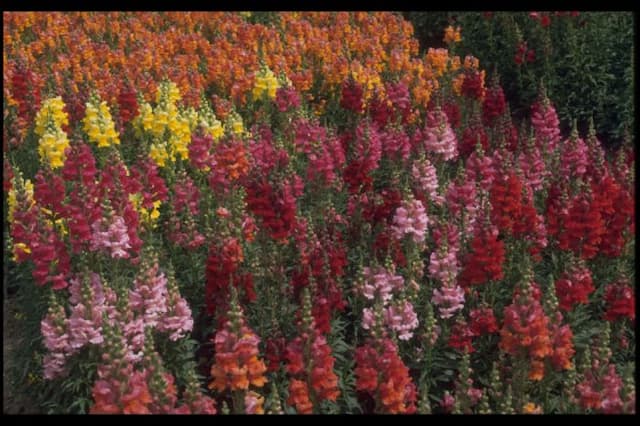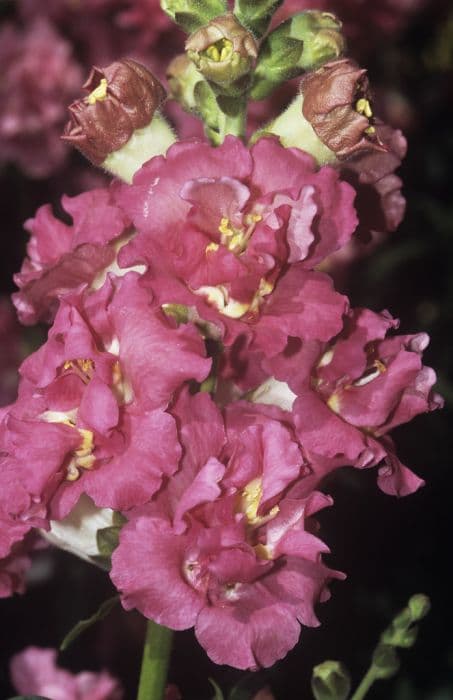Penstemon 'Purple Riding Hood' Penstemon 'Purple Riding Hood' (PBR) (Riding Hood Series)

ABOUT
'Purple Riding Hood' has rich, purple-pink flowers with prominent white stamens. Compact,lowbranchinggrowing habit, reaching about 60cm
About this plant
 Names
NamesFamily
Plantaginaceae
Synonyms
Beardtongue, Purple Beardtongue
Common names
Penstemon 'Purple Riding Hood' (PBR)
 Characteristics
CharacteristicsLife cycle
Perennials
Foliage type
Deciduous
Color of leaves
Green
Flower color
Purple
Height
1-2 feet (30-60 cm)
Spread
1-2 feet (30-60 cm)
Plant type
Herb
Hardiness zones
3-8
Native area
North America
Benefits
 General Benefits
General Benefits- Attractive Flowers: The plant features showy, tubular purple flowers that attract the attention of garden visitors and add a splash of color to the landscape.
- Pollinator-Friendly: Penstemon 'Purple Riding Hood' is known to attract bees, hummingbirds, and butterflies, providing a valuable food source for these beneficial pollinators.
- Drought Tolerance: Once established, this Penstemon is relatively drought-tolerant, making it suitable for water-wise gardens and areas with dry climates.
- Low Maintenance: It requires minimal care, making it an ideal plant for beginners or those looking for low-maintenance gardening options.
- Long Blooming Period: It has a longer blooming season, from late spring to early fall, providing prolonged visual interest in the garden.
- Deer Resistance: The plant is resistant to browsing by deer, which makes it ideal for gardens in areas where deer are a common problem.
- Versatile Use: Suitable for borders, rock gardens, and as a cut flower, it has versatile uses in landscaping and floral arrangements.
- Hardiness: It is hardy in a range of climates, typically from USDA zones 3 to 8, enabling it to withstand cooler temperatures.
- Compact Growth Habit: This variety has a compact and upright growth habit, which makes it well-suited for small gardens or tight spaces.
 Medical Properties
Medical PropertiesThis plant is not used for medical purposes.
 Air-purifying Qualities
Air-purifying QualitiesThis plant is not specifically known for air purifying qualities.
 Other Uses
Other Uses- Crafting natural dyes: Penstemon flowers can be used to create a range of purple dyes for coloring fabrics, wool, and other materials.
- Edible flower decoration: The flowers of some Penstemon species are edible and can be used as a decorative, colorful garnish for salads and desserts.
- Fragrance extraction: The plant's flowers could potentially be used in the production of natural fragrances or potpourri to add a fresh, floral scent to a room.
- Photography subject: With their vivid color and beautiful form, Penstemon blooms are often used as a striking subject for botanical and garden photography.
- Garden design: Penstemon plants can be used in xeriscaping, a landscape design that requires minimal irrigation, due to their drought-tolerant nature.
- Floral art: Their tall, spiky blooms make Penstemon an interesting component in floral arrangements and live plant displays.
- Motivational tool: Gardeners might use the challenge of growing Penstemon, which sometimes requires specific conditions, to hone their horticultural skills.
- Educational tool: Penstemon can serve as a hands-on educational subject for lessons in botany, ecology, and plant physiology.
- Beekeeping support: Since Penstemon is attractive to bees, planting it can support local beekeeping efforts and pollinator health.
- Living mulch: Due to its foliage, Penstemon can be used as living mulch to retain soil moisture and reduce weed growth around other garden plants.
Interesting Facts
 Feng Shui
Feng ShuiThe Beardtongue is not used in Feng Shui practice.
 Zodiac Sign Compitability
Zodiac Sign CompitabilityThe Beardtongue is not used in astrology practice.
 Plant Symbolism
Plant Symbolism- Resilience: Penstemons can thrive in tough conditions, symbolizing the ability to withstand and adapt to life’s challenges.
- Health and vitality: With their vivid colors and robust growth, they represent a vibrant spirit and good health.
- Boldness: Their striking appearance stands out in a garden, which can be seen as a symbol of courage and the willingness to be seen.
- Diversity: The variety within the Penstemon genus signifies the beauty of diversity and the importance of embracing different qualities.
 Water
WaterThe Beardtongue should be watered deeply once a week, allowing the soil to dry out slightly between waterings. This translates to about 1 inch of water per week or roughly 0.6 gallons for an average-sized plant. In the peak of summer, especially in hot, dry climates, you may need to water twice a week. Water at the base of the plant to avoid wetting the foliage, which can lead to fungal diseases. It's less about the frequency and more about maintaining consistent moisture while avoiding waterlogged soil.
 Light
LightBeardtongue prefers full sun conditions but can tolerate some partial shade, especially in hotter climates where some afternoon shade can protect it from the intense heat. The best spot would be one where it receives at least six hours of direct sunlight daily, which encourages healthy growth and abundant flowering.
 Temperature
TemperatureBeardtongue thrives in a wide range of temperatures, from as low as 20°F in winter to over 90°F in summer. However, the ideal growing temperature for this plant is between 60°F and 75°F. It is hardy in USDA zones 3 through 8, indicating its adaptability to various climates.
 Pruning
PruningPrune Beardtongue plants to remove spent flower spikes and encourage a second bloom. This is typically done after the first wave of flowering finishes, in midsummer. Additionally, trim the plants back in late fall or early spring to maintain a tidy appearance and promote healthy, vigorous growth. The best time for major pruning is in the spring, just as new growth begins.
 Cleaning
CleaningAs needed
 Soil
SoilBeardtongue prefers well-draining soil enriched with organic matter, with a preferred pH range of 6.0 to 8.0. A mix of loam, sand, and compost is ideal for ensuring good drainage and fertility.
 Repotting
RepottingBeardtongue doesn't require frequent repotting and can thrive in the same pot for several years, repot only when the plant outgrows its current container.
 Humidity & Misting
Humidity & MistingBeardtongue is tolerant of a wide range of humidity levels and thrives best in moderate conditions without the need for any special humidity adjustments.
 Suitable locations
Suitable locationsIndoor
Place in bright light and ensure well-draining soil.
Outdoor
Choose sunny spot, well-draining soil, and water moderately.
Hardiness zone
4-9 USDA
 Life cycle
Life cyclePenstemon 'Purple Riding Hood,' also known as Beardtongue, begins its life cycle when a seed germinates, typically in the spring, in well-drained soil with full sun exposure. The seedling emerges and develops into a vegetative plant, growing leaves and stems. As the plant matures, it forms a sturdy base with numerous stems and leaves, preparing for flowering. Flowering usually occurs in early summer to midsummer, showcasing its vibrant purple tubular flowers which attract pollinators such as bees and hummingbirds. After pollination, the plant sets seeds that mature by late summer, which can be dispersed to produce new plants. During the fall and into winter, the plant may die back, especially in colder climates, but its perennial nature allows it to regrow from its roots the following spring.
 Propogation
PropogationPropogation time
Spring-Early Summer
Propogation: The most popular way to propagate Penstemon 'Purple Riding Hood' is by cuttings, typically taken during the late spring or early summer when the plant's growth is most vigorous. To propagate by cuttings, a gardener should select a healthy stem and cut a piece about 3 to 5 inches long just below a leaf node. It's important to use a sharp, clean cutting tool to avoid damaging the plant and to prevent disease. The bottom leaves of the cutting are removed, and the cut end is often dipped in rooting hormone powder to encourage root development. The prepared cutting is then placed in a well-draining soil mixture and should be kept moist until roots have established, which usually takes a few weeks. To create a suitable environment for rooting, the cutting can be covered with a plastic bag or placed in a propagator to maintain high humidity.





![Snapdragon [Pretty in Pink]](/_next/image?url=https%3A%2F%2Fplants-admin.emdemapps.com%2Fimages%2Fplants%2F%2Fimages%2F604b5cb3b5385.png&w=640&q=75)



